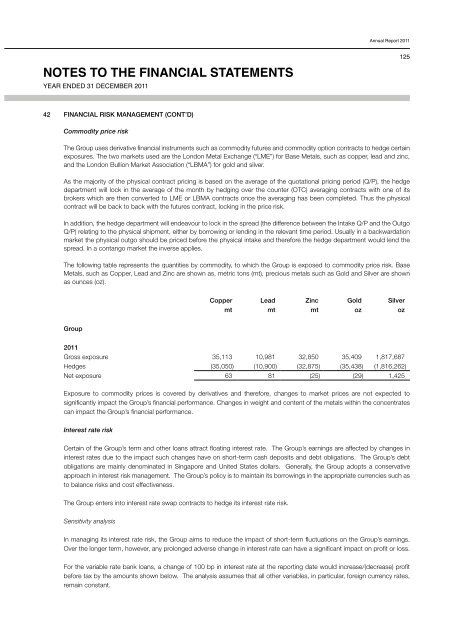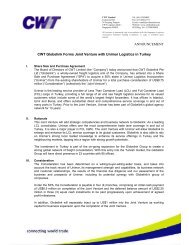notes to the financial statements - Investor Relations
notes to the financial statements - Investor Relations
notes to the financial statements - Investor Relations
Create successful ePaper yourself
Turn your PDF publications into a flip-book with our unique Google optimized e-Paper software.
NOTES TO THE FINANCIAL STATEMENTS<br />
YEAR ENDED 31 DECEMBER 2011<br />
42 FINANCIAL RISK MANAGEMENT (CONT’D)<br />
Commodity price risk<br />
Annual Report 2011<br />
The Group uses derivative <strong>financial</strong> instruments such as commodity futures and commodity option contracts <strong>to</strong> hedge certain<br />
exposures. The two markets used are <strong>the</strong> London Metal Exchange (“LME”) for Base Metals, such as copper, lead and zinc,<br />
and <strong>the</strong> London Bullion Market Association (“LBMA”) for gold and silver.<br />
As <strong>the</strong> majority of <strong>the</strong> physical contract pricing is based on <strong>the</strong> average of <strong>the</strong> quotational pricing period (Q/P), <strong>the</strong> hedge<br />
department will lock in <strong>the</strong> average of <strong>the</strong> month by hedging over <strong>the</strong> counter (OTC) averaging contracts with one of its<br />
brokers which are <strong>the</strong>n converted <strong>to</strong> LME or LBMA contracts once <strong>the</strong> averaging has been completed. Thus <strong>the</strong> physical<br />
contract will be back <strong>to</strong> back with <strong>the</strong> futures contract, locking in <strong>the</strong> price risk.<br />
In addition, <strong>the</strong> hedge department will endeavour <strong>to</strong> lock in <strong>the</strong> spread (<strong>the</strong> difference between <strong>the</strong> Intake Q/P and <strong>the</strong> Outgo<br />
Q/P) relating <strong>to</strong> <strong>the</strong> physical shipment, ei<strong>the</strong>r by borrowing or lending in <strong>the</strong> relevant time period. Usually in a backwardation<br />
market <strong>the</strong> physical outgo should be priced before <strong>the</strong> physical intake and <strong>the</strong>refore <strong>the</strong> hedge department would lend <strong>the</strong><br />
spread. In a contango market <strong>the</strong> inverse applies.<br />
The following table represents <strong>the</strong> quantities by commodity, <strong>to</strong> which <strong>the</strong> Group is exposed <strong>to</strong> commodity price risk. Base<br />
Metals, such as Copper, Lead and Zinc are shown as, metric <strong>to</strong>ns (mt), precious metals such as Gold and Silver are shown<br />
as ounces (oz).<br />
Group<br />
Copper Lead Zinc Gold Silver<br />
mt mt mt oz oz<br />
2011<br />
Gross exposure 35,113 10,981 32,850 35,409 1,817,687<br />
Hedges (35,050) (10,900) (32,875) (35,438) (1,816,262)<br />
Net exposure 63 81 (25) (29) 1,425<br />
Exposure <strong>to</strong> commodity prices is covered by derivatives and <strong>the</strong>refore, changes <strong>to</strong> market prices are not expected <strong>to</strong><br />
significantly impact <strong>the</strong> Group’s <strong>financial</strong> performance. Changes in weight and content of <strong>the</strong> metals within <strong>the</strong> concentrates<br />
can impact <strong>the</strong> Group’s <strong>financial</strong> performance.<br />
Interest rate risk<br />
Certain of <strong>the</strong> Group’s term and o<strong>the</strong>r loans attract floating interest rate. The Group’s earnings are affected by changes in<br />
interest rates due <strong>to</strong> <strong>the</strong> impact such changes have on short-term cash deposits and debt obligations. The Group’s debt<br />
obligations are mainly denominated in Singapore and United States dollars. Generally, <strong>the</strong> Group adopts a conservative<br />
approach in interest risk management. The Group’s policy is <strong>to</strong> maintain its borrowings in <strong>the</strong> appropriate currencies such as<br />
<strong>to</strong> balance risks and cost effectiveness.<br />
The Group enters in<strong>to</strong> interest rate swap contracts <strong>to</strong> hedge its interest rate risk.<br />
Sensitivity analysis<br />
In managing its interest rate risk, <strong>the</strong> Group aims <strong>to</strong> reduce <strong>the</strong> impact of short-term fluctuations on <strong>the</strong> Group’s earnings.<br />
Over <strong>the</strong> longer term, however, any prolonged adverse change in interest rate can have a significant impact on profit or loss.<br />
For <strong>the</strong> variable rate bank loans, a change of 100 bp in interest rate at <strong>the</strong> reporting date would increase/(decrease) profit<br />
before tax by <strong>the</strong> amounts shown below. The analysis assumes that all o<strong>the</strong>r variables, in particular, foreign currency rates,<br />
remain constant.<br />
125





